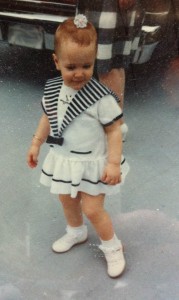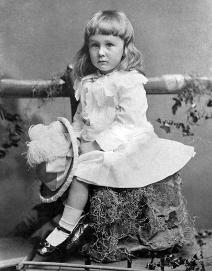
little me in my sailor get up complete with earrings, “hair” bow and patent leather shoes similar to those on FDR’s feet.
Today, we are constantly trying to label boys and girls at a glance. We just have to know. Riiiight… now. Enter color codes. Also enter earrings at 6 weeks old and all the double-sided taped on “hair” bows! What? I was pretty much bald until I was three.
Pink and blue were labeled as colors for babies in the mid-19th century but the two colors were not promoted as blue cap for baby boys and pink cap for baby girls until just before World War I. This is history, folks. (herstory?)
The picture below is of Franklin Delano Roosevelt as a youngster. At a glance, to our societal standards today he actually looks like a she, with long locks and sporting a skirt. Yet societal norms of 1884, when FDR at age 2 ½ , dictated that boys wore dresses until they were about 7 years old and this was the time of their first haircut as well. This outfit in those times was indeed gender neutral.
Developing these color codes for hospital purposes makes sense. It makes the nurses jobs a tad easier by not having to undo a child’s diaper to identify the correct gender before placing them back in what is *hopefully* the correct crib in the hospital nursery. But really, how did we end up with two “teams” for clothing? (which has now transcended and leached into every part of kid culture clearly defining that blue is for boys and pink is for girls).
Jo B. Paoletti a historian at the University of Maryland and author of the published book, Pink and Blue: Telling the Girls from the Boys in America was quoted in a Smithsonian article answering why there is now two sides.
“It’s really a story of what happened to neutral clothing,” says Paoletti, who has explored the meaning of children’s clothing for 30 years. For centuries, she says, children wore dainty white dresses up to age 6. “What was once a matter of practicality—you dress your baby in white dresses and diapers; white cotton can be bleached—became a matter of ‘Oh my God, if I dress my baby in the wrong thing, they’ll grow up perverted,’ ” Paoletti says.
Wait a minute though! According to a June 1918 article from the trade publication Earnshaw’s Infants’ Department said, “The generally accepted rule is pink for the boys, and blue for the girls.” Pink back in the day was viewed as a strong color whereas blue was softer and more dainty. Even Time magazine agreed! In 1927, the magazine printed a chart showing gender specific colors for girls and boys according to the leading department stores of the time.
Soooo I guess pink hasn’t always been a girl thing. SHUT THE FRONT DOOR, RIGHT? So how in the world (literally) did it get flip-flopped to the gender color codes we are beaten over the head with daily? (not literally)
It’s not where, but who and when these gender specific color wheels were established. Year: 1940
Who: Marketers dictating these new norms and pushing “buy in” from the public. (No surprise there) Girls were to dress like their mothers and boys were to dress like their fathers.
Today many parents are struggling with conforming to gender roles or to letting their little one make decisions for themselves. A-list celebrity Angelina Jolie is well known for allowing her 6-year-old daughter Shiloh to dress as she pleases. She told Vanity Fair in 2010 that Shiloh dresses like “a little dude” and “thinks she’s one of the brothers.” I think for a parent it takes guts to allow your child, especially at such a young age, to dictate their own wardrobe choices! I respect Shiloh’s bravery to challenge societal stereotypes and be free (via her mother) to express herself. (Although at 6 she may not realize it)
Another challenge of these color code norms was last week. I was happy yet shocked when a friend of mine who is a dance teacher said on the first day of class when the 7-year-old girls, clad in their pink leotards and tights, introduced themselves saying their name, school and favorite color—five out of the eight girls said blue or light blue. Blue, a color that is predominantly gender specific as being a “boy” color. The one girl who said pink was her favorite looked at my friend quizzically, almost saying with her expression, “what’s wrong with them.”
I wonder why this is? What makes these five girls pick a different color other than pink…they could have picked purple (one did) or green or red…but why blue? Maybe they’re tired of being forced to like pink by society?(coughmarketerscough) Maybe girls are tired of being choked by the pink aisle when they go into the toy store, clothing store, or any store. Remember Riley? These girls in my friend’s dance class are all versions of Riley. Dressed in pink leotards looking for a blue one!
Again, these marketer-created color codes dictate what is “right” for little girls to identify with. Pink is for girls, blue is for boys. That’s just how it is. But they are challenging that, which is empowering and refreshing.
Do you think marketers should change up their color coded equation an offer products similar to Goldie Blox for little girls? Offer more gender-neutral clothing? For example, if a pair of blue corduroys does it have to have a football on them? Can’t they just be plain and therefore gender neutral? And…some girls like to play football, amiright?
For more samples of how gender neutral our society was back in history, lookie here!

